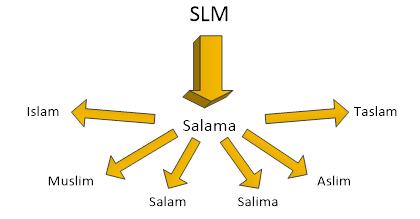This final background article provides some additional material for understanding Islam. We will take a quick look at the ancestry of the Arab peoples, the Arab language, and some common cultural practices that carried over from pre-Islamic times. These will become relevant later as we look at Islam’s growth, and the development of its tenets and sources.
Arab Ancestry
Arab Muslims often claim to be descended from Ishmael. However, the Arab peoples are far older than Ishmael and trace their roots to other individuals. The word Arab does not appear until the 9th century BC in Assyria. From the book of Genesis we have the following peoples identified:
The descendants of Noah’s son Japheth include Gomer, Magog, Madai, Javan, Tubal, Meshech and Tiras. From these the coastlands of the nations were separated into their lands, every one according to his language, according to their families, into their nations. (Gen. 10:2-5)
- The descendants of Noah’s son Ham include Cush, Mizraim, Put, and Canaan. From Cush came Nimrod who went into Assyria and founded the city of Nineveh. Mizraim’s descendants included the Philistines. The descendants of Canaan settled in the land from Sidon to Gaza. (Gen. 10:6-20)
- The descendants of Noah’s son Shem include Peleg, ‘for in his days the earth was divided; and his brother’s name was Joktan.’ Joktan’s descendants included Almodad, Sheleph, Hazarmaveth, Jerah, Hadoram, Uzal, Diklah, Obal, Abimael, Sheba, Ophir, Havilah, and Jobab. They settled in the hill country of the east. (Gen. 10:21-32)
- Lots daughters from whom the Moabites and Ammonites descended. (Gen. 19:37-38)
- The descendants of Abraham through his second wife Keturah, after the death of Sarah. These descendants included Zimran, Jokshan, Medan, Midian, Ishbak, and Shuah. These and the sons of his concubines he sent to the east away from his son Isaac. (Gen. 25:1-6)
- The descendants of Jacob’s brother Esau. Esau was the father of the Edomites. (Gen. 36:9-43)
- The descendants of Ishmael included Nebaioth, Kedar, Adbeel, Mibsam, Mishma, Dumah, Massa, Hada, Tema, Jetur, Maphish, and Kedemah. Ishmael settled in the lands to the east of Egypt toward Assyria in defiance of all his relatives. (Gen. 25:12-18) Additional information about Ishmael in Genesis says that ‘his hand will be against everyone, and everyone’s hand will be against him; and he will live to the east of all his brothers.’ (Gen. 16:12) Kedar is the father of the Bedouins.
From the above, it is the Bedouins alone who can make a clear claim as being a descendent of Ishmael.
Arab Language
The Arab language is a Semitic one. In the sixth century the Arab language consisted of a string of unmarked characters that represented consonants. It did not possess the pointing or diacritical marks of modern Arabic that are used to both distinguish some consonants from one another and determine what short vowels are inserted and where the insertion occurs. Without pointing it was impossible to distinguish between consonants such as: b from t or th, f from q, j from h and kh, s from d, r from z, s from sh, d from dh, and t from z. This had several implications for understanding written text from this period. Either the individual had to: (1) be present when the words were spoken, (2) be told what was said by a trustworthy transmitter (referred to as isnad), or (3) derive the meaning from the text itself.
Without these marks, it was possible to develop a great number of variant readings from the same text. These variant readings were not simply grammatical differences in tense, person, or subject-verb agreement. Instead their insertion produced phrases and statements with totally different meanings from the same source text. Literally thousands of different variant readings could be created from the same written text, produced simply by where the user decided to place these marks and what marks they determined to use. Different sets of rules later developed to apply these marks to text. As we will see later, the Medinan codex selected by Uthman as the true Qur’an, and this codex was written in unpointed text without diacritical marks. The above characteristics of the Arabic language all had implications for the eventual derivation of its meaning.
One quick example from the Answering Islam website which looks at the formation of and relationship between some words that are relevant to the topic of these articles. A three letter infinitive verb forms the root for many different words. The meaning of these derived words may or may not be related. Take, for example, the Arabic root SLM. From this root we get the infinitive SaLaMa, which means ‘the way of security’ or ‘the path of safety’. All of the words below are derived from this same infinitive.

The meaning of each of these words is discussed below.
ISLaM – submission to the will of Allah
MuSLiM – one who submits to the will of Allah
SaLaM – peace
SaLiMa – to be saved or escape from danger
ASLiM – see below
TaSLaM – see below
On the surface there does not appear to be any direct relationship between the words above. To add to this perception there are two other derivatives from the infinitive Salama which mean ‘the stinging of a snake’ and ‘the tanning of leather’.
Despite these surface differences, at another level I believe that a relationship exists between these words, including the two additional derivatives just mentioned. First, all of the above words involve some external action between two parties, an act of submission. One submits to another, one is saved by another, one succumbs to the bite of a snake, or leather submits to the tanner’s beating to make it soft and supple. I think it is no different for the word meaning peace. In our culture we usually assume peace to be the normal state that is interrupted at times by conflict. Not so within the Bedouin culture. As we will see in a later article, within this culture conflict was assumed to be the normal state and peace was what came after conflict had ended – another form of submission. This brings us to the meaning of the words Aslim and Taslim. Toward the end of his life Muhammad would sign the letters he sent to groups demanding they accept Islam with the closing Aslim, Taslim. This phrase has two equivalent meanings; surrender and you will be safe, or surrender or face death. In other words submit and you will be safe.
In my opinion, these words all involve the action of one party submitting to another, thereby achieving a type of safety, a meaning very much like the definition of the infinitive salama. Even the bite of a snake. In the desert, most snakes are venomous. Submitting to the bite of a snake often brought one to the submission brought about by death. We will return to this aspect of language later when we discuss the formation of some of Islam’s tenets.
Arabic Practices
It is difficult to ascertain many of the customs and practices within Arabic culture prior to Muhammad. Why? Because the early caliphs ordered all things pre-Muhammad, that did not support Islam, to be destroyed. This included all literature, all poetry, all history, and all art. What we know comes from a few non-Arabic sources.
Below are a few common pre-Islamic practices from Arab culture that we know about. With the exception of the first two items and the last one, all of these practices carried over into Islam. Verses within the Qur’an prohibited the practice of female infanticide. Verses related to the Zaynab affair changed the status of adopted children. They were no longer considered to be the offspring of those who adopted them. Finally, the status of women within Islam is very clear, and this position is also sanctioned by verses from within the Qur’an and other Islamic sources.
Female infanticide (a pagan practice also performed within the Roman Empire, but reduced as the influence of Christianity grew).
Children who were adopted, culturally and legally, became the offspring of the person adopting them.
Child weddings to girls as young as 8 or thereabouts.
Multiple wives.
Frequent blood feuds and payment of blood wit.
Use of tribal leaders as arbiters.
The owning of slaves.
The tribe/clan was paramount in society, but these ties were beginning to fade and be replaced by economic mutual interests in the sixth century.
The role and status of women is unclear. Some sources suggest they were treated as property. Other sources indicate that property was passed through the female’s family, that they participated equally with their men in taking care of their clan, and that females contracted to be wives for a specific period of time. Muhammad’s first wife Khadija was a widow who had significant wealth of her own. She hired Muhammad to be in charge of some of her caravans as a business manager– caravans which she appears to have funded. One of the bases for their eventual marriage was Muhammad’s success in managing her caravans.
In the next article, we will begin our study of Islam’s development by looking at Muhammad’s life and what he taught.
DOWNLOAD PDF
 Author and speaker, Dan Wolf, is gifted at gathering facts about contemporary subjects and sharing information in a manner that is easy to read and understand. Dan will be posting both historical and current information about Islam and Sharia on the VCA website.
Author and speaker, Dan Wolf, is gifted at gathering facts about contemporary subjects and sharing information in a manner that is easy to read and understand. Dan will be posting both historical and current information about Islam and Sharia on the VCA website.




